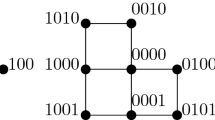Abstract
A unit cube in \({\mathbb{R}^k}\) (or a k-cube in short) is defined as the Cartesian product R 1 × R 2 × ... × R k where R i (for 1 ≤ i ≤ k) is a closed interval of the form [a i , a i + 1] on the real line. A k-cube representation of a graph G is a mapping of the vertices of G to k-cubes such that two vertices in G are adjacent if and only if their corresponding k-cubes have a non-empty intersection. The cubicity of G is the minimum k such that G has a k-cube representation. From a geometric embedding point of view, a k-cube representation of G = (V, E) yields an embedding \({f: V(G) \rightarrow \mathbb{R}^k}\) such that for any two vertices u and v, ||f(u) − f(v)||∞ ≤ 1 if and only if \({(u, v) \in E(G)}\) . We first present a randomized algorithm that constructs the cube representation of any graph on n vertices with maximum degree Δ in O(Δ ln n) dimensions. This algorithm is then derandomized to obtain a polynomial time deterministic algorithm that also produces the cube representation of the input graph in the same number of dimensions. The bandwidth ordering of the graph is studied next and it is shown that our algorithm can be improved to produce a cube representation of the input graph G in O(Δ ln b) dimensions, where b is the bandwidth of G, given a bandwidth ordering of G. Note that b ≤ n and b is much smaller than n for many well-known graph classes. Another upper bound of b + 1 on the cubicity of any graph with bandwidth b is also shown. Together, these results imply that for any graph G with maximum degree Δ and bandwidth b, the cubicity is O(min{b, Δ ln b}). The upper bound of b + 1 is used to derive upper bounds for the cubicity of circular-arc graphs, cocomparability graphs and AT-free graphs in terms of the maximum degree Δ.
Similar content being viewed by others
References
Adiga A.: Cubicity of threshold graphs. Discrete Math. 309(8), 2535–2537 (2009)
Adiga, A., Chandran, L.S.: Cubicity of interval graphs and the claw number. European Conference on Combinatorics, Graph Theory and Applications (EuroComb 2009). Electron. Notes in Discrete Math. 34, 471–475 (2009)
Afshani, P., Chan, T.M.: Approximation algorithms for maximum cliques in 3d unit-disk graphs. In: Proceedings of 17th Canadian Conference on Computational Geometry (CCCG), pp. 6–9 (2005)
Agarwal P.K., van Kreveld M., Suri S.: Label placement by maximum independent set in rectangles. Comput. Geom. 11(3–4), 209–218 (1998)
Berman P., DasGupta B., Muthukrishnan S., Ramaswami S.: Efficient approximation algorithms for tiling and packing problems with rectangles. J. Algorithms 41(2), 443–470 (2001)
Chandran L.S., Das A., Shah C.D.: Cubicity, boxicity, and vertex cover. Discrete Math. 309(8), 2488–2496 (2009)
Chandran L.S., Francis M.C., Sivadasan N.: Geometric representation of graphs in low dimension using axis-parallel boxes. Algorithmica 56(2), 129–140 (2010)
Chandran L.S., Mannino C., Orialo G.: On the cubicity of certain graphs. Inform. Process. Lett. 94(3), 113–118 (2005)
Chandran L.S., Mathew K.A.: An upper bound for cubicity in terms of boxicity. Discrete Math. 309(8), 2571–2574 (2009)
Erlebach T., Jansen K., Seidel E.: Polynomial-time approximation schemes for geometric intersection graphs. SIAM J. Comput. 34(6), 1302–1323 (2005)
Feige, U.: Approximating the bandwidth via volume respecting embeddings. In: Proceedings of the 30th Annual ACM Symposium on Theory of Computing, pp. 90–99. ACM Press (1998)
Fishburn P.C.: On the sphericity and cubicity of graphs. J. Combin. Theory Ser. B 35(3), 309–318 (1983)
Heckmann R., Klasing R., Monien B., Unger W.: Optimal embedding of complete binary trees into lines and grids. J. Parallel Distrib. Comput. 49(1), 40–56 (1998)
Kloks, T., Kratsch, D., Borgne, Y.L., Müller, H.: Bandwidth of split and circular permutation graphs. In: Proceedings of the 26th International Workshop on Graph-Theoretic Concepts in Computer Science (WG 2000), LNCS, vol. 1928. pp. 243–254. Springer, Berlin (2000)
Kloks T., Kratsch D., Müller H.: Approximating the bandwidth of asteroidal triple-free graphs. J. Algorithms 32(1), 41–57 (1999)
Kratsch D., Stewart L.: Domination on cocomparability graphs. SIAM J. Discrete Math. 6(3), 400–417 (1993)
Kratsch D., Stewart L.: Approximating bandwidth by mixing layouts of interval graphs. SIAM J. Discrete Math. 15(4), 435–449 (2002)
Maehara H.: Sphericity exceeds cubicity for almost all complete bipartite graphs. J. Combin. Theory Ser. B 40(2), 231–235 (1986)
Michael T., Quint T.: Sphere of influence graphs and the L ∞-metric. Discrete Appl. Math. 127(3), 447–460 (2003)
Michael T., Quint T.: Sphericity, cubicity, and edge clique covers of graphs. Discrete Appl. Math. 154(8), 1309–1313 (2006)
Roberts, F.S.: On the boxicity and cubicity of a graph. In: Recent Progresses in Combinatorics, pp. 301–310. Academic Press, Dublin (1969)
Rosgen B., Stewart L.: Complexity results on graphs with few cliques. Discrete Math. Theor. Comput. Sci. 9(1), 127–136 (2007)
Turner J.: On the probable performance of heuristics for bandwidth minimization. SIAM J. Comput. 15(2), 561–580 (1986)
Unger, W.: The complexity of the approximation of the bandwidth problem. In: Proceedings of the 39th Annual Symposium on Foundations of Computer Science, pp. 82–91. IEEE Computer Society (1998)
van Leeuwen, E.J.: Approximation algorithms for unit disk graphs. In: Proceedings of the 31st International Workshop on Graph-Theoretic Concepts in Computer Science (WG 2005), LNCS, vol. 3787, pp. 351–361 (2005)
Yannakakis M.: The complexity of the partial order dimension problem. SIAM J. Algebraic Discrete Methods 3(3), 351–358 (1982)
Author information
Authors and Affiliations
Corresponding author
Rights and permissions
About this article
Cite this article
Chandran, L.S., Francis, M.C. & Sivadasan, N. Cubicity and Bandwidth. Graphs and Combinatorics 29, 45–69 (2013). https://doi.org/10.1007/s00373-011-1099-x
Received:
Revised:
Published:
Issue Date:
DOI: https://doi.org/10.1007/s00373-011-1099-x




